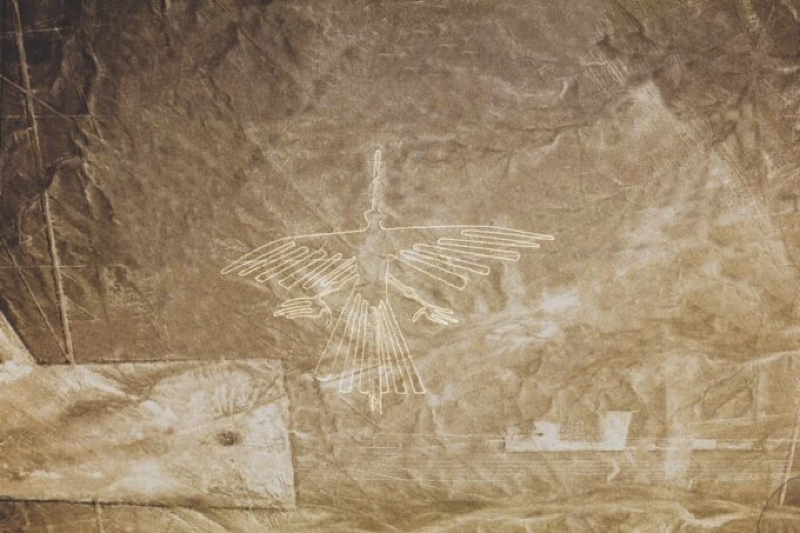An AI survey reveals hundreds of new ‘Nazca Line’ geoglyphs

From Gizmodo: "It took a century for researchers to discover 430 geoglyphs, some massive, spread across the ground in the Nazca region of Peru. Now, a team of scientists has nearly doubled the count of known geoglyphs in just six months, using an AI-driven approach to reveal some of the harder-to-spot figures. The Nazca Lines refer to a collection of these geoglyphs in the Nazca Pampa; between roughly 200 BCE and 500 CE, local groups removed the darker rocks on the arid landscapes surface, revealing the white sandy soil below. They did this on smaller scales but also on glyphs so large that they can only be properly seen from the air. The lines are ancient but were rediscovered en masse in the 20th century; nevertheless, some went under the radar. In 2020, a feline geoglyph—as in, it depicts a cat—was found on a hillside in the region."
The Olympian who was declared dead and then came back to win gold

From WBUR: "Betty Robinson qualified for the 1928 Olympic Games in Amsterdam. Her timing couldn’t have been better. Before 1928, the Olympics hadn’t included track and field events for women. Women could swim. They could compete at archery. They couldn’t run. When the numbers went up, Betty had won the first gold to be given to a woman for track and field. Shortly after that, Robinson, who’d initially seen running as a lark, began to take what she’d accomplished more seriously. Then she decided on one hot afternoon during the summer of 1931 to interrupt her training with a ride in an airplane. People still don’t know how it happened, but the plane that they were piloting suddenly stalled, just outside of Chicago, and they plunged to the ground. When Betty was found, she was unresponsive. She was bleeding from a head wound. The man who found her believed her to be dead so he took her to an undertaker."
Scientists believe that dark matter could be hiding out as atom-sized black holes

From Scientific American: "Black holes the size of an atom that contain the mass of an asteroid may fly through the inner solar system about once a decade, scientists say. Theoretically created just after the big bang, these examples of so-called primordial black holes could explain the missing dark matter thought to dominate our universe. And if they sneak by the moon or Mars, scientists should be able to detect them, a new study shows. Such black holes could have easily arisen right after the universe was born, when space is thought to have expanded hugely in a fraction of a second. During this expansion, tiny quantum fluctuations in the density of space would have grown larger, and some spots may have become so dense that they collapsed into black holes scattered throughout the cosmos. If dark matter is fully explained by such black holes, their most likely mass, according to some theories, would range from 1017 to 1023 grams."
The well-liked school custodian who turned out to be a former SS officer

From Chicago magazine: "Jack Swanson walked into his second-floor office at Oak Park and River Forest High School. It was December 4, 1982, and this three-room suite next to the boardroom had been his for the last eight years, after he had beaten out 60 other administrators vying to run the storied west suburban school. Swanson settled into his chair and opened the Chicago Sun-Times for some light reading. A headline on the bottom right-hand corner of page 7 caught his eye: “Deportation Bid on Suburb Man.” He scanned the article, and a wave of shock rushed over him. It had to be a misprint, some kind of misunderstanding. Maybe it was a different man with the same name? No, the Sun-Times left no room for doubt. The next few seconds were a blur, the words almost impossible to believe. Reinhold Kulle, the high school’s custodian, had been a Nazi."
The real reason Americans often associate pineapples with Hawaii

From Tasting Table: "In the minds of many Americans, pineapples are directly tied to the Hawaiian Islands. The Spruce Eats states that Christopher Columbus had a hand in spreading the golden fruit across the globe after transporting it to Europe from the island of Guadeloupe in the late 1400s, but the pineapple took quite a few journeys across unrelated waters before finding its way into American culinary culture. Botanically named Ananas comosus, the fruit became known as pineapple due to its similarity in appearance to a pine cone. Native to Brazil, Paraguay, and Argentina — not Hawaii – no one is sure who should be credited with introducing the fruit to the area. The name Don Francisco de Paula Marin has been mentioned as a possible source, a Spanish sailor who provided the first written account of the fruit in the early 1800s. Regardless of how it got there, the pineapple went on to become one of the most highly prized and expensive fruits in the world. This didn't escape the notice of young American entrepreneur James Dole."
The top 10 mobile phone designs from 2000
The top ten mobile phone designs from the year 2000. pic.twitter.com/LpCiJUMXsg
— Figen (@TheFigen_) September 24, 2024
Acknowledgements: I find a lot of these links myself, but I also get some from other newsletters that I rely on as "serendipity engines," such as The Morning News from Rosecrans Baldwin and Andrew Womack, Jodi Ettenberg's Curious About Everything, Dan Lewis's Now I Know, Robert Cottrell and Caroline Crampton's The Browser, Clive Thompson's Linkfest, Noah Brier and Colin Nagy's Why Is This Interesting, Maria Popova's The Marginalian, Sheehan Quirke AKA The Cultural Tutor, the Smithsonian magazine, and JSTOR Daily. If you come across something interesting that you think should be included here, please feel free to email me at mathew @ mathewingram dot com



